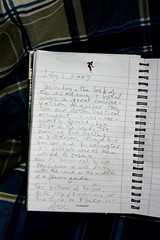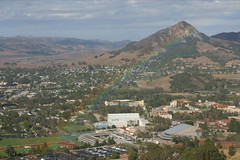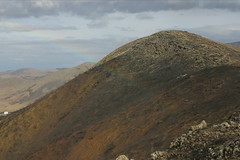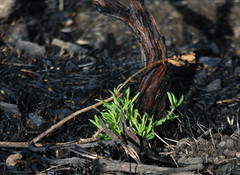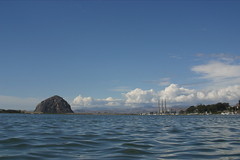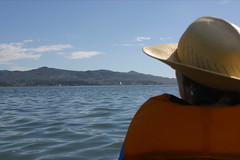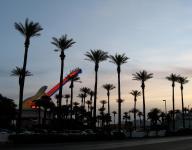Hello Mike
Thanks for the thoughtful and detailed response to my question. I hope that it can serve to further some University-wide discussion of what I believe is the most consequential issue regarding Global Warming that Cal Poly faces right now.
That is, whether or not President Baker should the Presidents Climate Commitment:
http://www.presidentsclimatecommitment.org/html/commitment.php.
The primary author of that document, Anthony Cortese, visited the campus for several days this month, delivering a public lecture, meeting with several local Sustainability groups, and conferring privately with the President and Vice Presidents.
On several occasions Cortese stated that his mission was not so much to convince President Baker to join the 434 College and University Presidents nationwide in signing on as to promote public deliberation about this issue among all members of the University Community.
Whether or not we sign on to the specific terms of this Commitment, what Cortese asked was that the University move now, decisively and dramatically, to address the climate crisis and the need for leadership toward sustainability. Only the President of the University can direct such a move, but all the rest of us should be made aware of his options and reasons for action or inaction.
First of all, what is the actual commitment? It has three provisions:
1. Initiate the development of a comprehensive plan to achieve climate neutrality as soon as possible.
2. Initiate two or more of the following tangible actions to reduce greenhouse gases while the more comprehensive plan is being developed. [Cal Poly has already complied with this]
3. Make the action plan, inventory, and periodic progress reports publicly available.
One of Cortese’s main concerns was that objections to signing were not necessarily to the actual terms of the commitment.
The first objection you state is that true carbon neutrality cannot be achieved without our buying unaffordable and dubious carbon offsets.
There is considerable controversy in the environmental community as to whether buying offsets or sequestering carbon are meaningful ways of reducing GHG emissions. Thus, when the PCC requires us to set a schedule for reaching neutrality, when we don’t know if/how that can be achieved, the exercise is not entirely intellectually honest.
I think that was Yale’s position on the PCC: although they have set a goal to be “the greenest university in the world” (and have made some very noteworthy progress in this regard, including being on the forefront of GHG reductions), the president did not want to sign the actual PCC statement because he didn’t know how/if neutrality could really be achieved.
Thus, if the PCC is largely symbolic with regard to neutrality, then I’d prefer we were more upfront in saying that neutrality is a goal to be strived for, rather than saying we will set a schedule that hasn’t a realistic basis.
The commitment’s “Solutions” page states that “In general, buying carbon offsets to achieve climate neutrality should only be done as a last resort.”
The commitment is to achieving carbon neutrality “as soon as possible.” This gives the institution flexibility to set realistic targets and make adjustments as it tries to meet them. However this flexibility doesn’t mean that the commitment is mere lip-service, since it does require a plan, an inventory, and periodic reporting that demands an explanation for failure to make progress.
To me this is a sensible approach given the urgency of the situation. In the last few years, as documented in your well-crafted reports, Cal Poly has made what could be interpreted as impressive progress. However, that progress is not measured against any standard, and thereby gives no indication of how we really are doing compared either to other institutions or to targets defined by the demands of reducing emissions at a rate determined by scientific consensus to be necessary and feasible.
Yale’s objection may carry weight since they have instituted alternative targets and metrics for tracking progress toward an ambitious and clearly stated set of climate goals.
http://www.yale.edu/sustainability/YaleClimateInitiative.pdf
But no such initiative has materialized at Cal Poly. Our 2004 signing of the Talloires Declaration, positive though it has been in raising the profile and legitimacy of Education for Sustainability, has produced no measureable institutional targets and timetables for change, nor any discernible shifts in financing priorities to make such change possible.
Carbon neutrality may seem an unrealistic goal given many people’s present-day mindset, but as the consequences of global warming become more evident, that perception is changing. Our own governor, in signing a law passed by the state legislature stated:
“Using market-based incentives, we will reduce carbon emissions to 1990 levels by the year 2020. That’s a 25 percent reduction. And by 2050, we will reduce emissions to 80 percent below 1990 levels. We simply must do everything in our power to slow down global warming before it’s too late.”
By signing and fulfilling the Presidents Climate Commitment, Cal Poly would contribute its momentum to the initiatives of higher education nationwide as well as of the state of California.
Your next objection questions the appropriateness of Cal Poly’s taking the lead in moving our whole society toward climate neutrality:
My other concerns are secondary. First, as a public institution that will likely require public funding to achieve neutrality, the question should be raised: is this the most cost-effective use of public monies for reducing carbon emissions? Are we sure that bringing the public university sector to neutrality will achieve more benefits to the climate than using equal public monies in other sectors? Again, it’s the question of symbolism versus realistic solutions to a crisis. If we think we must act drastically now, we should direct our resources to those places that have the greatest results, fastest.
434 Presidents have agreed that Universities are appropriate institutions to lead the way, including the Chancellor of the University of California. Others, who haven’t signed the Presidents Climate Agreement like the President of Yale, also have taken steps in funding programs that are not merely symbolic but substantive. Universities house the next generation, which will be more affected by climate change than the present one and which will carry out the kinds of innovations and transformations that need to be developed now. In addition, Universities are also large institutions with correspondingly large environmental footprints.
Your next objection concerns possible abuses the Presidents Climate Commitment.
there is a potential problem with the need to earn a “gold star” versus really helping the environment. For example, at the UC/CSU/CCC sustainability conference last summer, a speaker suggested that the most important action UCI had taken to reduce GHG emissions was to build significant on-campus housing. More than one person remarked, however, that by bringing the housing on campus, the university would now have a bigger carbon “footprint” to “neutralize”…so wouldn’t it be better to not build the housing on campus so that campus neutrality would be easier? This goes back to my critique that by focusing on the university, we may lose sight of the truly global nature of the climate problem and that sometimes the best environmental answer may not be the one that gets a particular campus to neutrality.
This seems to be a problem of the accuracy of the metrics used in implementing the agreement. But as I understand it, each university that signs determines its own standards of measurement. Such technical problems are more likely to be solved if we become stakeholders in the process than if we use them as a reason to back off.
The example you mention illustrates some of the complexities involved in earning gold stars. In our biannual sustainability report, a good deal of credit is claimed for the construction of on-campus housing, despite the fact that Poly Canyon Village is adding two huge parking structures for the use of residents, which will encourage the increased use of automobile transportation on campus and in the local area.
Your last objection is based on a broader reason to discourage signing of the President’s Climate Agreement:
I am personally concerned by certain perspectives that suggest that the scientific inquiry regarding the causes and effects of climate change is “closed.” We always try to act on the best available science, but we should not close off intellectual/scientific debate or research. Scientists, academics and humans generally have certainly barked up wrong trees before. I have my father’s school text on environmental science from the late ’40’s. It notes that the greatest scientific breakthroughs to benefit humanity so far in the 20th century were 1) antibiotics (ok) and 2) DDT … because of how it eliminated malaria from many parts of the world. Hmmm. (I’ve read that limited use of DDT is again garnering favor in parts of the developing world for just that reason.)
I concede that skepticism about the reality of global warming or about humanity’s role in causing it or beliefs that there is nothing we can do about it undermine the immense resolve required to take responsibility for combating it. The science supporting the claim that we must act now to avoid future catastrophe is highly technical and the conclusion is not intuitively obvious. And in some cases, as you state, widely held scientific conclusions have been proven wrong.
But the risks of not acting on what has emerged as strong scientific consensus are today greater than those attendant upon waiting for more certainty. Two days ago, Science Daily reported
Secretary-General Ban Ki-moon has challenged the world’s policymakers to start devising a comprehensive deal for tackling climate change at next month’s summit in Bali, Indonesia, after a United Nations report released Nov. 17 found that global warming is unequivocal and could cause irreversible damage to the planet.
Finally then it comes down to whom to believe. At this point even the present administration in Washington acknowledges human causality for climate change, though it fails to do anything about it. This is why state and local governments, businesses, and other institutions of civil society are taking on the task. Education is at the forefront of these. The signatories of the Presidents’ Climate Agreement constitute a credible authority unreasonable for our President not to believe.
In addition to addressing the reservations you state, I’d like to mention a few of the positive benefits to be realized by our making the President’s Climate Commitment.
1. It provides a specific action program and timetable to guide the University in enacting provisions of the Talloires Declaration to which we already are signatory. Included is the creation of “institutional structures to guide the development and implementation of the plan.”
2. It provides an extensive “implementation guide” and a network of communication among other Universities participating in the program.
3. It provides access to funding sources”private, foundation and government”that can offset startup costs for implementing the plan
4. It provides a concrete statement of a shared mission that can
¢ engage all members of the university community
¢ heighten motivation of current students to succeed, especially in scientific and technical fields
¢ attract the most talented of prospective students who have realized that their future depends on dealing with the problem of climate change
¢ make graduates more competitive in a job market that demands the skills and inventiveness that arise out of accepting this challenge.
In conclusion, I’d like to reiterate what Anthony Cortese reported about the response on campuses at which Presidents signed the commitment. He said it has changed the level of conversation, it has raised the excitement, it has made it easier to discover ways to include sustainability in all curricular activities with incentives rather than requirements. As to why they made the decision to sign, the most frequent reply of the Presidents was “Because it’s the right thing to do.”


